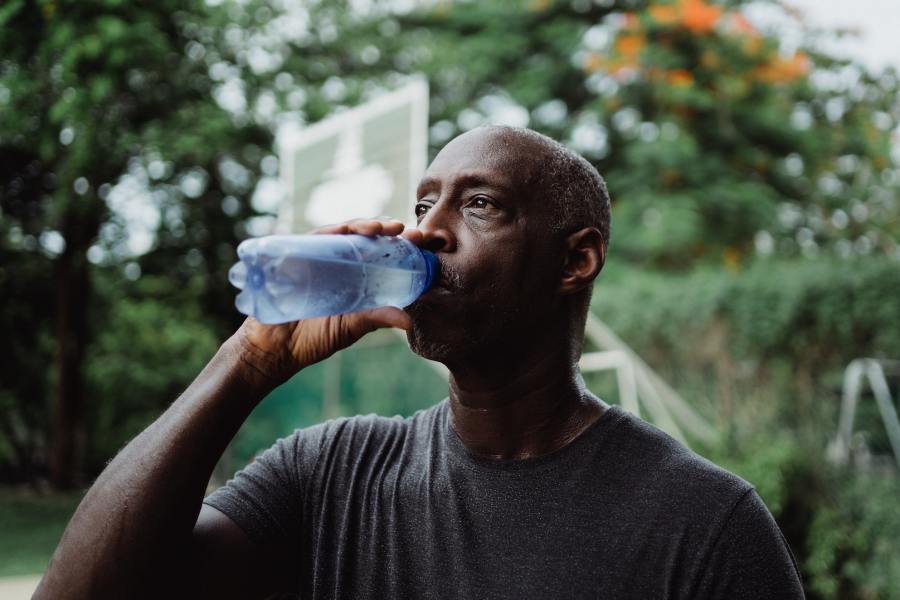6 Essential Health and Fitness Tips for Summer
The longer days of summer provide an excellent opportunity to get outside and change up your exercise and fitness routine. In fact, most fitness instructors recommend changing your routine often to avoid workout burnout, keep your muscles challenged and increase your flexibility. Switching up your workout routine may be just what you need to supercharge your energy and motivation and help you meet your summertime fitness and health goals.
At the same time, the heat and humidity during the hotter months can lead to serious health issues if you don’t take precautions to set yourself up for fitness success. Before you start your warm-weather workouts, learn the symptoms to look for and what to do if you (or your workout partner) show signs of dehydration or a heat-related illness.
Remember to set realistic goals that make sense for your body type and current fitness level. Plus, take time to acclimate to your new routine — don’t quickly switch from the treadmill in an air-conditioned gym to a fun run around the lake in 90-degree heat.
Below are some health and fitness tips to help you get in shape or stay in shape during the warm summer weather.*
How much water should you drink in a day?

About 60% of the body consists of water. Most people should drink 4-6 cups of water per day in addition to other sources of hydration such as water-rich foods and healthy beverages. However, this amount varies from person to person and depends on activity levels and ambient temperature.
According to the Academy of Nutrition and Dietetics, “A quick and easy way to check if you are getting enough water overall is to take a peek at the color of your urine. If you are consuming enough, the urine color will be a pale yellow color. If it is a dark yellow or amber color, you may need to increase the amount you consume.” To avoid dehydration while working out:
Pre-hydrate before working out and take water breaks during strenuous activity.
By the time you feel thirsty, you may already be dehydrated so carry a refillable water bottle to make it convenient to hydrate throughout the day.
The hotter it is, the more you sweat, increasing the need for water replacement.
It is possible to over hydrate which can result in sodium loss and muscle cramps. Drinking fluids with electrolytes (low-sugar sports drinks or adding electrolytes to plain water) can help replenish sodium levels.
What to eat to maximize your workouts
It’s widely recommended to eat before exercising. If you don’t, you may not have enough energy to complete your workout and may end up burning fewer calories.
Don’t eat right before your workout. Instead, have a small healthy meal 1-3 hours before you exercise. This puts fuel in the tank and helps burn stored fat for energy rather than the calories you just ate. Forbes Health states, “Eat the right foods at the right time, and you’ll provide your body with plenty of high-octane fuel to support high-energy exercises.”
For morning workouts, eat healthy carb and protein options such as whole-grain cereal with banana or blueberries for breakfast.
Choose lean, high-protein foods like grilled chicken for muscle health and appetite control. Healthline has some great high-protein suggestions for vegan or vegetarian diets.
Including water-rich foods like fruit, cucumbers or lettuce will increase hydration.
Sunscreen and protection from UV rays

UV rays from the sun increase the risk of skin cancer and eye disease and can cause the appearance of premature aging. In fact, skin cancer from UV radiation is the most common cancer in the United States. The CDC provides tips on how to protect yourself from damaging UV rays including:
Use sunscreen with a sun protection factor (SPF) 15 or higher, for both UVA and UVB protection.
Wear clothes that cover your arms and legs.
Wear a wide-brim hat to shade your face, head, ears, and neck.
Wear wraparound sunglasses that block both UVA and UVB rays.
Outdoor exercise options

The great outdoors provides extensive workout options from intense cardio or fully body High-Intensity Interval Training (HIIT) to a brisk walk. Many people combine exercise with a nature activity, team sport, or other group events. Some outdoor workout options include:
Hiking flat trails or uneven terrain, power walking, or strolling for longer distances.
Jogging, or running for general fitness or training for a marathon, half-marathon, 10K, or 5K.
Mountain biking or road biking.
Team sports such as tennis, pickleball, softball, soccer, or outdoor basketball.
Swimming in pools, lakes, or the ocean if you’re near the coast.
Equipment-free body weight exercises such as pushups, lunges, squats, and planks.
Workout recovery
To increase your fitness and improve your health you push your body to become stronger. It’s also important to let your body rest and recover to get the maximum benefit from your exercise. Everyday Health offers some key workout recovery strategies including:
Passive recovery — a complete cessation of exercise.
Active recovery — low-intensity, low-impact exercise to promote blood flow and tissue repair without further stressing the body.
Cross-training — changing up your workout routine each time so that you use different muscles each session.
Myofascial release — soft tissue therapy like massage or foam rolling.
Nutritional recovery — eating a diet rich in antioxidants, whole carbohydrates, and lean protein.
Sleep — during sleep, the body produces most of its growth factors and hormones that aid in daily muscle repair and recovery.
Workout accountability — Sticking to your fitness goals
Sticking with your fitness goals can be hard and it’s easy to find reasons to miss or delay your workouts. To stay motivated, set goals that are attainable and realistic so that when you meet them, you feel a sense of accomplishment. If you miss a day, don’t give up. Start again the next day. It’s not an all-or-nothing strategy. Fitness can happen every day, in big or small ways. The trick is to keep it top of mind and find every opportunity to grab some “health time” for yourself. Some other ways to help with workout accountability include:
Apps that track your fitness activities and help keep you moving.
Find some accountability partners or join a fitness community. These are people you check in with, or workout with, or even share your app data with.
Get into a healthy competition or fitness challenge if you find that motivating.
Post your favorite motivational quote where you’ll see it often.
Celebrate your successes based on your own goals — every step is a step in the right direction.
Summertime means longer days, warmer weather, and the opportunity to break up the monotony of your indoor workouts or jumpstart your fitness routine if you’ve slowed down over the colder months. If you want to improve your cardio health, build muscle, and burn calories, create a strategy that works for your body, fitness level, and schedule. It will make it easier to stick to your fitness goals not only during the summer but into the fall and beyond.
Interested in Sedera Medical Cost Sharing as a non-insurance solution to paying for healthcare? Sedera Members belong to a Community of people who share in the costs of one another’s medical burdens and commit to a healthy lifestyle. Learn more about affordable healthcare with medical cost sharing.
*SEDERA DOES NOT PROVIDE MEDICAL ADVICE. The information contained herein is for informational and/or educational purposes only and is not intended or implied to be a substitute for professional medical advice. Always seek the advice of your physician or other qualified healthcare provider with any questions you may have regarding a medical condition or treatment.